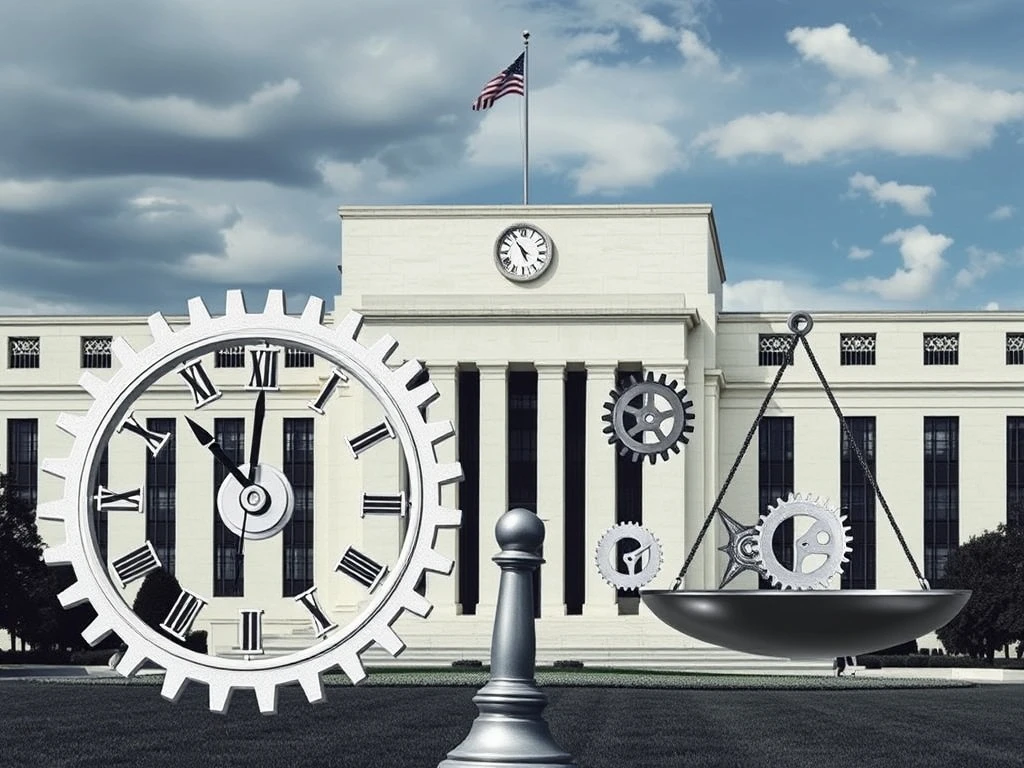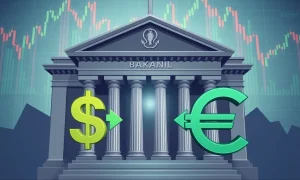Many market participants currently anticipate a **September rate cut** from the Federal Reserve. This expectation stems from recent economic data. However, a prominent Fed watcher suggests this outcome is far from a certainty. Indeed, a ‘messy’ compromise may instead await investors and the broader economy. Understanding the nuances of the Fed’s decision-making process is crucial for anyone navigating the current financial landscape.
Understanding the Federal Reserve’s Dual Mandate
The Federal Reserve operates under a dual mandate. First, it aims to achieve maximum sustainable employment. Second, it seeks to maintain price stability, typically defined as low and stable inflation. These two goals often require careful balancing. Policymakers continuously evaluate incoming economic data to inform their decisions. Furthermore, they consider both domestic and international factors.
Recent economic indicators show mixed signals. The labor market, for instance, has demonstrated resilience. Job growth remains steady, and unemployment rates are historically low. Conversely, inflation has shown signs of cooling. The Consumer Price Index (CPI) and Personal Consumption Expenditures (PCE) data provide key insights. Therefore, the Fed must weigh these competing forces carefully. Their actions directly influence borrowing costs, consumer spending, and business investment. Consequently, the prospect of a **September rate cut** hinges on their assessment of these complex variables.
Arguments Favoring a September Rate Cut
Proponents of a **September rate cut** point to several key developments. Firstly, inflation has decelerated from its peak. This trend suggests that past monetary tightening measures are effectively working. Secondly, some argue that the labor market, while strong, shows early signs of softening. For example, wage growth might be moderating. Thirdly, a rate cut could prevent an overly restrictive monetary policy. Such a policy risks triggering an unnecessary economic slowdown. Therefore, easing rates could support continued economic expansion without reigniting inflation. Many analysts believe a preemptive move is better than reacting to a downturn. This perspective suggests the Fed should act before economic conditions deteriorate significantly. Furthermore, global economic uncertainties also play a role. A rate cut could provide a buffer against external shocks. Consequently, a **September rate cut** is seen by many as a timely adjustment to evolving economic realities.
Why a September Rate Cut Remains Uncertain
Despite widespread expectations, a **September rate cut** is not a guaranteed outcome. Several factors contribute to this uncertainty. A prominent Fed observer recently highlighted these concerns. Firstly, inflation, while lower, might still be above the Fed’s comfort zone. Core inflation metrics, which exclude volatile food and energy prices, remain persistent. This stickiness suggests underlying price pressures. Secondly, the labor market continues to surprise with its strength. Strong employment figures could indicate sustained demand. Such demand could fuel inflationary pressures. Therefore, the Fed might worry about cutting rates too soon. A premature cut could undo progress made against inflation. Thirdly, geopolitical risks add another layer of complexity. These risks can disrupt supply chains or impact energy prices. Such disruptions could reignite inflation. Consequently, the Fed might opt for a more cautious approach. This caution would delay any potential **September rate cut**. Furthermore, policymakers often prefer to see sustained evidence of inflation moving towards their target. A single good report may not be enough. This cautious stance emphasizes data dependency over fixed timelines.
Navigating the ‘Messy’ Path to Monetary Policy
The term ‘messy compromise’ suggests a scenario beyond a simple rate cut or hold. It implies a complex negotiation among policymakers. Various views exist within the Federal Open Market Committee (FOMC). Some members may favor immediate easing. Others might advocate for maintaining higher rates for longer. A ‘messy compromise’ could involve a smaller-than-expected cut. Alternatively, it might entail a delay in the cutting cycle. For instance, the Fed might signal future cuts without committing to a **September rate cut**. This approach allows flexibility based on new data. It also manages market expectations. The compromise might also involve different communication strategies. For example, the Fed could emphasize its data-dependent approach even more strongly. This ambiguity could lead to increased market volatility. Therefore, investors must prepare for a range of outcomes. Understanding the internal dynamics of the FOMC is crucial. This complex environment demands careful analysis from all market participants.
Market Impact and Investor Strategies Amid Rate Uncertainty
The prospect of an uncertain **September rate cut** significantly impacts financial markets. Equities, bonds, and the U.S. dollar all react to changes in interest rate expectations. A delayed or smaller cut could lead to higher bond yields. This situation makes fixed-income investments more attractive. However, it could also weigh on stock valuations. Companies often face higher borrowing costs in a high-rate environment. Conversely, a clear signal for a **September rate cut** could boost equity markets. Lower rates reduce the cost of capital. This reduction encourages corporate investment and consumer spending. The U.S. dollar also reacts sharply. Higher rates typically strengthen the dollar. Lower rates tend to weaken it. Therefore, currency traders closely watch Fed announcements. Investors should consider diversifying their portfolios. They might also re-evaluate their risk tolerance. Remaining agile and responsive to new information is key. This uncertainty underscores the importance of a well-thought-out investment strategy.
Historical Context of Federal Reserve Decisions
Examining past Federal Reserve cycles provides valuable context for the current debate. Historically, the Fed has navigated various economic challenges. These include periods of high inflation, recessions, and financial crises. For instance, during the early 1980s, the Fed aggressively raised rates to combat runaway inflation. This action led to a recession but ultimately restored price stability. More recently, the Fed rapidly cut rates during the 2008 financial crisis and the 2020 pandemic. These actions aimed to stabilize financial markets and support economic recovery. However, each cycle presents unique circumstances. Today’s environment features a resilient labor market alongside persistent inflation. Therefore, drawing direct parallels can be misleading. The Fed’s decisions are always data-dependent. They also reflect the prevailing economic theories and policy tools available. Understanding this history helps contextualize the potential implications of a **September rate cut** or its delay. It highlights the complex trade-offs involved in monetary policy. Consequently, historical analysis can offer insights into potential Fed reactions.
Global Influences on the September Rate Cut Debate
The Federal Reserve does not operate in a vacuum. Global economic conditions significantly influence its decisions. For example, economic slowdowns in major trading partners can impact U.S. exports. This situation affects domestic growth and employment. Furthermore, central bank policies in other developed nations also play a role. If the European Central Bank or the Bank of England begin cutting rates, it could put pressure on the Fed. Such actions might lead to a stronger dollar, impacting U.S. competitiveness. Geopolitical events, such as conflicts or trade disputes, also create uncertainty. These events can disrupt global supply chains. They can also affect commodity prices, influencing inflation. Therefore, the Fed closely monitors international developments. Its policy decisions aim to stabilize the U.S. economy while considering global interdependencies. A potential **September rate cut** must account for these external forces. The interconnectedness of the global economy means that domestic policy cannot ignore international realities. Thus, global factors add another layer of complexity to the Fed’s deliberations.
Key Economic Indicators Shaping the September Rate Cut Outlook
Several critical economic indicators will heavily influence the Fed’s decision regarding a **September rate cut**. Policymakers meticulously analyze these data points. Firstly, inflation reports, particularly the Consumer Price Index (CPI) and the Personal Consumption Expenditures (PCE) price index, are paramount. The PCE is the Fed’s preferred inflation gauge. Sustained declines in these measures are crucial. Secondly, labor market data, including the monthly jobs report, unemployment rate, and wage growth, provide insights into economic health. A significant softening in the job market could prompt earlier rate cuts. Thirdly, retail sales figures indicate consumer spending trends. Robust spending suggests strong demand, potentially delaying cuts. Fourthly, manufacturing and services sector surveys, like the ISM PMIs, offer a snapshot of business activity. Weakening sentiment in these sectors could signal a need for stimulus. Finally, global economic data and geopolitical developments are also monitored. These indicators collectively paint a comprehensive picture. The Fed’s data-dependent approach means each new release can shift expectations for a **September rate cut**. Therefore, market participants must closely track these announcements.
Expert Perspectives on the September Rate Cut
The economic community holds diverse views on the likelihood and timing of a **September rate cut**. Many economists anticipate a gradual easing cycle. They believe inflation is trending downwards. They also see signs of a rebalancing labor market. This group generally supports a rate cut later this year. Conversely, a significant number of experts express caution. They point to the persistence of core inflation. They also highlight the surprising resilience of consumer spending. This group argues against an early cut. They fear reigniting inflationary pressures. Some analysts suggest that the Fed might prioritize its inflation fight. They believe the Fed would tolerate a slower growth period if necessary. Therefore, they foresee rates remaining higher for longer. Other experts emphasize the risk of overtightening. They worry about the potential for a recession if the Fed waits too long. This range of opinions reflects the complexity of the current economic environment. The ‘messy compromise’ concept truly captures this divergence. Ultimately, the Fed must synthesize these varied perspectives. Their decision on a **September rate cut** will reflect their collective assessment of the data and risks.
The debate surrounding a potential **September rate cut** underscores the dynamic nature of monetary policy. While many anticipate a move, a prominent Fed watcher’s caution highlights significant uncertainties. The Federal Reserve must balance its dual mandate of price stability and maximum employment. This balancing act involves navigating complex economic data, global influences, and diverse internal views. The prospect of a ‘messy’ compromise suggests a nuanced outcome. It will likely involve careful communication and a continued data-dependent approach. Investors should remain vigilant. They must adapt their strategies to potential shifts in the Fed’s stance. The path forward remains intricate, demanding ongoing analysis and informed decision-making.
Frequently Asked Questions (FAQs)
What is the Federal Reserve’s dual mandate?
The Federal Reserve’s dual mandate involves two primary goals: achieving maximum sustainable employment and maintaining price stability. This typically means keeping inflation low and stable, around 2%.
Why is a September rate cut not considered a ‘done deal’?
A September rate cut is not a ‘done deal’ because inflation, especially core inflation, remains somewhat persistent. Additionally, the labor market has shown surprising resilience. This strength could indicate continued demand and potential inflationary pressures, leading the Fed to adopt a more cautious approach.
What does a ‘messy compromise’ in monetary policy mean?
A ‘messy compromise’ refers to a situation where the Federal Reserve does not pursue a straightforward rate cut or hold. Instead, it might involve a smaller-than-expected cut, a delayed cutting cycle, or ambiguous communication. This reflects internal disagreements among policymakers and the need to balance conflicting economic signals.
How do global factors influence the Fed’s decision on a September rate cut?
Global factors, such as economic slowdowns in major trading partners, policies of other central banks, and geopolitical events (like conflicts or trade disputes), can influence the Fed’s decision. These factors can impact U.S. growth, inflation, and the dollar’s value, adding complexity to domestic monetary policy.
Which economic indicators are most crucial for the Fed’s decision?
Key economic indicators include inflation reports (CPI, PCE), labor market data (jobs report, unemployment rate, wage growth), retail sales, and manufacturing/services sector surveys (ISM PMIs). The Fed closely monitors these to assess the economy’s health and determine appropriate policy actions.








